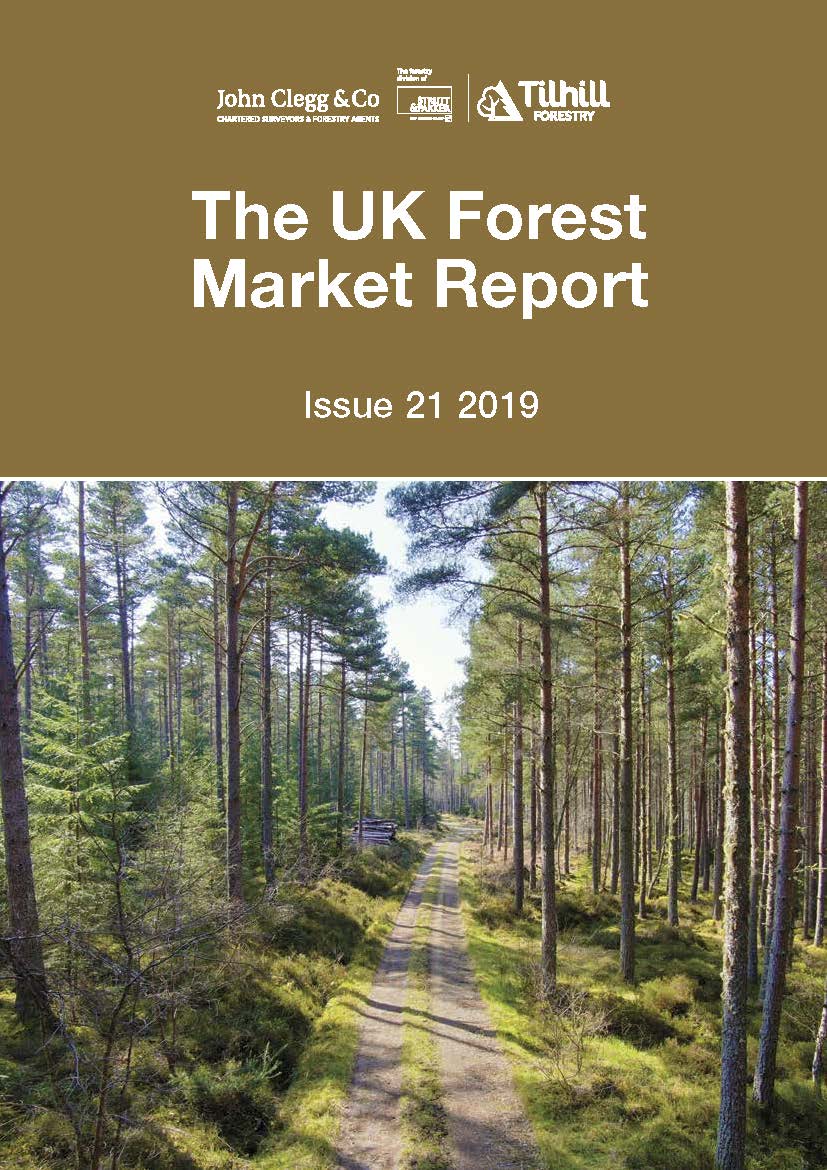The average price of commercial forestry on the market rose 23% over the last year, according to an industry leading report launched today (Wed 27th November) in London.
The 21st edition of the UK Forest Market Report, produced by Tilhill Forestry and John Clegg & Co, outlines a positive outlook for the “robust” market in its annual analysis and commentary on the forestry and woodland sector and highlights its “powerful attraction as an investment asset”.
Key Findings
• 23% Year-on-Year rise in average forestry values to £11,478 per stocked hectare (ha).
• 21% increase in the total value of the forestry market.
• Commercial forestry transactions worth £126.5m completed in the past year.
• 14,235 ha (gross) of forestry traded in 2019 (81 forests).
• Decrease in the average size of sold forestry property from 196 ha in 2018 to 136 ha.
• Average cost £1.56m.
• 69% of properties sold above their guide price with 14% of properties selling at more than 150% over guide.
• Continued strength in the mixed woodlands market.
• Scotland held the largest share of forestry market transactions (78% of recorded sales).
• Planting targets exceeded in Scotland.
• Positive outlook for forestry market.
Peter Whitfield, Business Development Director for Tilhill Forestry, said: “We have seen a continued upward trajectory in average forestry values, which rose by 23% over the past year. However, it must be stressed this is a volatile figure which is in part a reflection of the excellent quality of the forests which came to the market this year. Deviations in the quality of properties sold distort the comparison and, if we were to compare like for like examples, we would probably see something closer to a 10-12% rise. That said, there is clearly a genuinely strong uplift in the market.”
Figures show a 21% increase in the total value of the market, which amounted to £126.5m. A total of 69% of properties sold above their guide price with 14% of properties selling at more than 150% over guide. The average size of a sold forestry property decreased to 136 ha (from 196 ha in 2018) and the average cost amounted to £1.56m.
An interesting selection of properties came to the market, attracting a wide variety of investors, according to the report. In Scotland, where 78% of recorded sales took place, five properties sold above the £5m mark and 15 properties sold below £500,000.
Investing in Forestry
Fenning Welstead, Director at John Clegg & Co, said: “Our report for 2019 shows that forests have continued to rise in value. With the softening of timber prices this year, it might be thought that forest property values should follow suit. This is not happening and we believe that this is a direct reflection of the trend towards renewable resources and a move to a low carbon economy.
“We believe the rise in land values reflects a desire to have such a fundamental asset as part of an investment portfolio. Ownership offers opportunities for alternative land uses; for example, renewable energy and commercial forestry crops are a popular blend. Additionally, with a potential carbon tax in development there is the possibility of an annual income for sequestering carbon.”
Woodland Creation
Much has been said about the ability of tree planting to help mitigate climate change and this will no doubt be a driver of future policy. The report suggests that interest in establishing new forests is high, yet despite government statements, it is really only active in Scotland. It is sufficiently confidence-inspiring that strong, competitive bidding for suitable land is lifting prices to new levels. This seems like the major change in land use that is needed if we are to materially increase forest cover in the UK, but the momentum needs to spread to England and Wales to achieve real success.
Scotland exceeded its own new planting target of 10,000 ha this year, with 11,210 ha of new woodland, and appears to be on course to do so again in the 2019/20 planting year. 85% of new planting took place in Scotland in 2018/2019.
Mixed Woodlands
The continued strength in the mixed woodlands market is also demonstrated with the report, which comprised 44 properties, representing about 2,250 acres offered with a total guide price of £9.252m. The total selling price was £9,603m, around 4% over guide.
These types of woodland offer exciting ownership opportunities to a range of investors. As the wider societal and environmental values that should be assigned to woodland through carbon, water quality, flood mitigation and biodiversity start to be recognised, it is expected that this market sector will attract a new class of environmentally-minded investor. Although prices have not risen as quickly as the productive conifer market, they still compare favourably and many remain more affordable for the smaller investor.
Conclusion
We can expect an unsettled few years ahead both politically and economically. In this environment, we can see the value and security of real assets that continue growing regardless of political uncertainty. This, along with a continued political support for forestry, aligned with a new impetus for woodland creation driven by growing climate change concerns, makes us optimistic about the future.
View the full report here



